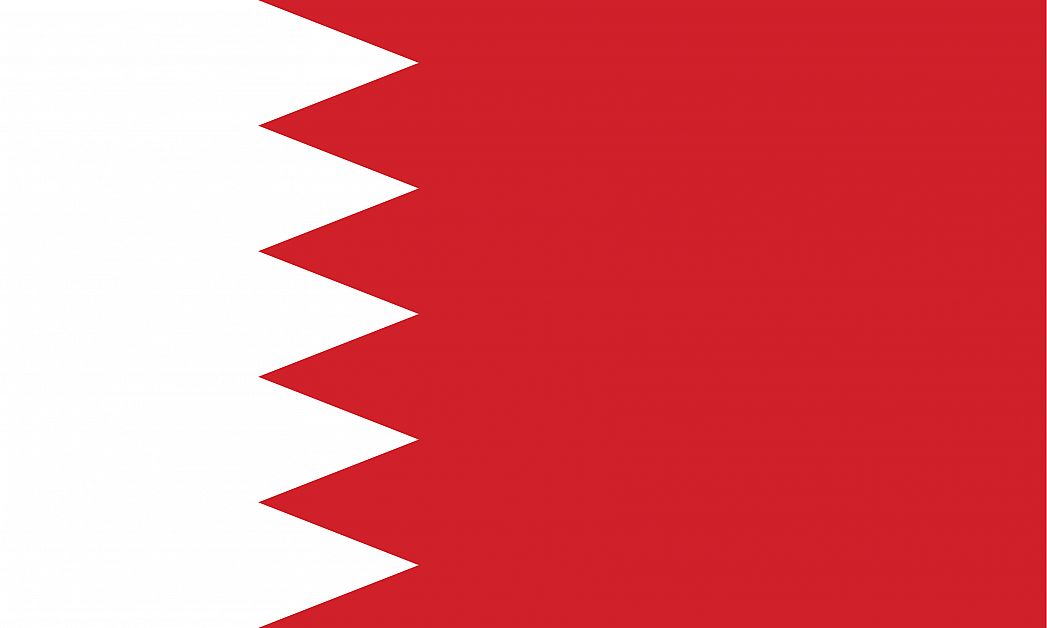Bahrain’s flag is officially known as the National Flag of Bahrain and consist of a vertical white band on the left separated from a vertical red band on the right by five triangles pointing to the right. These triangles form a serrated line thus making the white and red bands to seemingly appear as if they are an interlocking zigzag. All the triangles are Isosceles triangles with two equal sides and two equal angles. The whole flag is rectangular and has a proportion of 3:5. Bahrain officially adopted its flag on February 14, 2002.
Traditionally, Arab states of the Persian Gulf have the color red as part of the flag, however, the red on Bahrain’s flag also indicate the kharidschitsche belief that occupied a large part of the Arabian Peninsula. White represents truces that Bahrain made with the neighboring countries. The triangles on the flag represent the pillars of the Islamic religion which are Shahada (declaration of faith), Salat (the five daily prayers), Zakat (giving to charity based on accumulated wealth), Sawm (fasting), and Hajj (Pilgrimage to Mecca for those who are able). The white potion occupies 32.5% of the flag while the red occupies 67.5%.
Traditionally, many Arab states of the Persian Gulf have the color red as part of their flag, however, the red on Bahrain’s flag also indicate the kharidschitsche belief that occupied a large part of the Arabian Peninsula. White represents truces that Bahrain made with the neighboring countries. The triangles on the flag represent the pillars of the Islamic religion which are Shahada (declaration of faith), Salat (the five daily prayers), Zakat (giving to charity based on accumulated wealth), Sawm (fasting), and Hajj (Pilgrimage to Mecca for those who are able). The white potion occupies 32.5% of the flag while the red occupies 67.5%.
Traditionally, Arab states of the Persian Gulf have the color red as part of the flag, however, the red on Bahrain’s flag also indicate the kharidschitsche belief that occupied a large part of the Arabian Peninsula. White represents truces that Bahrain made with the neighboring countries. The triangles on the flag represent the pillars of the Islamic religion which are Shahada (declaration of faith), Salat (the five daily prayers), Zakat (giving to charity based on accumulated wealth), Sawm (fasting), and Hajj (Pilgrimage to Mecca for those who are able). The white potion occupies 32.5% of the flag while the red occupies 67.5%. Before Bahrain signed the General Maritime Treaty with the UK in 1820, the flag was plain red (the color of the Kharidjite Muslim sect). Between 1820 and 1932, a white vertical band was added on the left to represent truce. From 1932 to 1972, Bahrain added 28 white triangles to form a serrated boundary between the white and red to make it unique. This flag was the first Bahrani flag to be recognized through the influence of the British adviser Charles Belgrave. In 1972, just after gaining independence, until 2002, eight triangles replaced the previous 28 triangles.
This page was last modified on May 1st, 2018
More on Graphicmaps

Published on 2019-11-06
What is a Trade Embargo?

Published on 2019-11-04
Which Two Countries Used to Have the Same Flag?

Published on 2019-09-16
What Is the Only Two-Sided State Flag?

Published on 2019-09-16
Which Country Flag Looks Like the Texas Flag?

Published on 2019-08-29
Flags That Resemble the US Flag

Published on 2019-08-20
